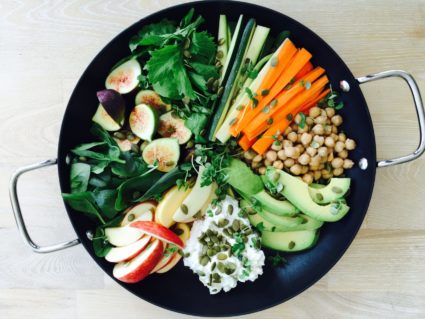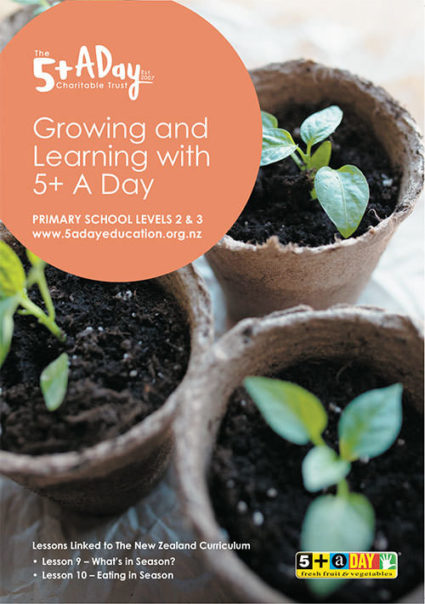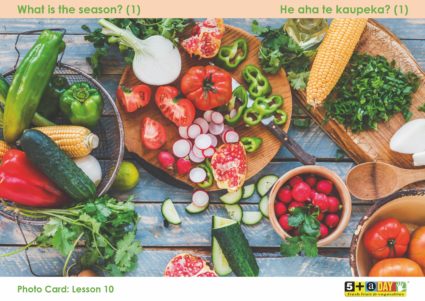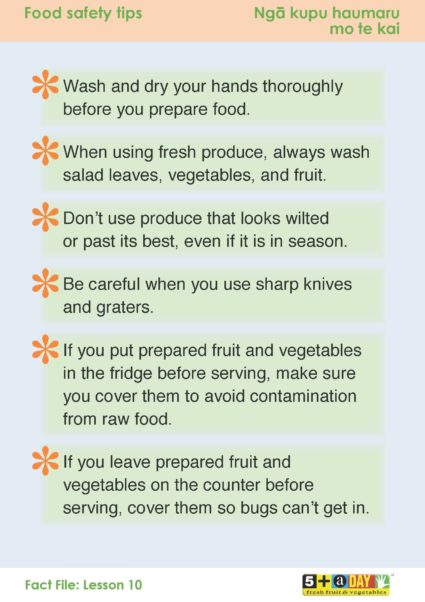Primary
Lesson 10: Eating in Season
In this lesson, students will continue to explore the availability and benefits of eating fresh fruit and vegetables in season. They will create a menu for a shared lunch according to the season and then prepare and share the meal.


This lesson is featured in our printed resource; Book 3: Growing and Learning with 5+ A Day, Levels 2 & 3.
Order the print version here or download here to print yourself.
Learning Intentions

Students will:
- identify when different fresh fruit and vegetables are available
- discuss the importance of buying and eating fresh fruit and vegetables in season.
Possible Achievement Objectives
Health and Physical Education: Level 2
SOCIETAL ATTITUDES AND VALUES
Students will:
- explore how people’s attitudes, values, and actions contribute to healthy physical and social environments.
COMMUNITY RESOURCES
Students will:
- identify and use local community resources and explain how these contribute to a healthy community.
Health and Physical Education: Level 3
SOCIETAL ATTITUDES AND VALUES
Students will:
- identify how health care and physical activity practices are influenced by community and environmental factors.
PERSONAL GROWTH AND DEVELOPMENT
Students will:
- identify factors that affect personal, physical, social, and emotional growth and develop skills to manage changes.
RIGHTS, RESPONSIBILITIES AND LAWS; PEOPLE AND THE ENVIRONMENT
Students will:
- contribute to and use simple guidelines and practices that promote physically and socially healthy classrooms, schools, and local environments.
Science: Level 2
ECOLOGY
Students will:
- recognise that living things are suited to their particular habitat.
Science: Level 3
PARTICIPATING AND CONTRIBUTING
Students will:
- use their growing science knowledge when considering issues of concern to them
- explore various aspects of an issue and make decisions about possible actions.
Preparation
What You Need
- eBook: Fredge’s 5+ A Day Feast
- Photo Cards: What is the season?/He aha te kaupeka? (1, 2, 3, 4)
- Fruit & Vegetable Availability Chart poster
- Fact File: Food safety tips/Ngā kupu haumaru mo te kai
- Resource Sheet: Menu for a shared salad lunch/Rārangi kai mo te paramanawa huamata
Key Vocabulary
These words are important to this lesson, and can be defined and explored in context as you discuss the topic with your students. A number of content words are provided in English and Māori. Introduce terms in both languages as appropriate.
harvest/hauhake: to pick or gather fruit or vegetable crops
import/kawe: to bring goods or products into a country to sell
nutrition/taioranga: eating healthy food that is good for you
pesticides/paturiha: chemicals that are used to destroy pests that harm or damage crops
seasonal/ā-kaupeka: growing in a particular season
tropical/pārū: an area where the climate is hot with a high rainfall (usually close to the Equator)
Learning Opportunity
This lesson follows on from Lesson 9. Students will take responsibility for their learning by creating a menu using seasonal fruit and vegetables and then preparing and sharing a meal. Your role will be to facilitate this and reinforce the key message of making good choices by buying and eating fresh seasonal fruit and vegetables.
The Lesson
eBook: Fredge’s 5+ A Day Feast
Begin the lesson by revisiting the eBook Fredge’s 5+ A Day Feast (click on the cover of the eBook). There is audio for this story that you can use, or students can take turns to read the text.
The focus of the eBook is to introduce the idea of buying and eating fresh fruit and vegetables when they are in season. For information on using 5+ A Day eBooks, click here.
There are two interactive activities that follow the eBook. They work on a computer, a tablet, or an IWB. They can be used during or at the end of the lesson or in choosing time to reinforce key information from the story. Students will get the most from these activities if you model them first and explain the actions required and the aims of the activity. Then students can do them independently or in pairs.
For Activity 9, help Aroha buy fresh fruit and vegetables in season by dragging the correct fruit or vegetables into the correct seasons. For Activity 10, help Jaden make a summer fruit pizza by dragging the correct summer fruit onto the pizza.
With the students, discuss the problem in the story and how it was resolved.
- What was Jaden’s problem?/He aha te raru a Jaden? (He wanted to make his special berry fruit salad, but he couldn’t buy berries because it was winter.)
How did Fredge help Jaden solve his problem? (He suggested that Jaden use winter fruit that were available, such as mandarins, kiwifruit, and persimmons.)/I pēwhea a Fredge e awhi ai ki a Jaden, kia tau tōna raru? (Nāna i ki mā Jaden e whakamahi ngā huawhenua e wātea ana i te hōtoke, pērā ki ngā manarini, huakiwi me nga āporo makimaki.)
Photo Cards: What is the season?/He aha te kaupeka?
Now show the students the Photo Cards: What is the season?/He aha te kaupeka? (1) and (2) (click on the image to enlarge, download, and print). Ask them to identify the season.
- In which season do you buy and eat these vegetables? (summer)
- Which vegetables do you like here?
- How do you like to eat them?/Ka pēwhea inā ka kaingia?
- In which season do you buy and eat these kinds of fruit? (summer)
- Which fruit do you like here?
- How do you like to eat them?/Ka pēwhea inā ka kaingia?
Repeat with the Photo Cards: What is the season?/He aha te kaupeka? (3) and (4), which shows vegetables and fruit that are available in winter. The students could use the What’s in Season? poster they looked at in Lesson 9 to confirm the seasonality of some of the fruit and vegetables.
Now the students can revisit the eBook and do Activity 10: Help Jaden make a summer fruit pizza, independently or in pairs. They can use the poster to help them decide in which season the fruit and vegetables are available.
Planning a shared lunch
Tell the students that in pairs they are going to create a salad menu for a restaurant using the fruit and vegetables that are currently in season. They can refer to the What’s in Season? poster to help them decide which vegetables and fruit to have. The students can use the Resource Sheet: Menu for a shared salad lunch/Rārangi kai mo te paramanawa huamata, to write their menu. You can click on the image and download the active PDF for them to complete (they can type directly into the spaces provided) or print the sheet for them to work on. The students need to:
- think of two or three simple fruit and vegetable dishes for starters, main courses, and desserts.
- write a title for each dish
- write a short sentence to describe the fruit and vegetables in each dish
- think of an inventive name for their restaurant (with a fruit and vegetable theme, such as the Salad Bowl).
The challenge for students is to include as many different seasonal coloured fruit and vegetables as they can (a rainbow of colours).
Tell the students that once they have reviewed the menus together, each student or pair will choose a salad dish that they can make for a shared lunch. Emphasise that the dishes need to be simple using seasonal fruit and vegetables.
Review the students’ menus as a class. Congratulate them on their creativity.
The students can now begin planning the shared lunch. Depending on your school’s facilities, the students could prepare and make their dishes at school or make them at home and bring them to school. They will need to write a list of the ingredients they need for the dish and find or write a recipe for it. If the students make their dishes at school, they will need to be supervised by an adult who has basic cooking skills and an understanding of safe food practices in the preparing of food.
Fact File: Food safety tips
Before the students begin preparing the shared lunch, share the Fact File: Food safety tips/Ngā kupu haumaru mo te kai (click on the image to enlarge, download, and print) with them.
Reflect on the Learning
This is the time to reflect on the learning outcomes for the lesson. It is also a time for students to talk about and share ideas that are still unclear. In reflecting on this lesson after the shared lunch has taken place, focus the discussion on the importance of buying and eating fruit and vegetables in season. Review the preparation and execution of the shared lunch.
- What was it like using seasonal fruit and vegetables?/Ka pēwhea te whakamahi i ngā huarākau me ngā huawhenua ā-kaupeka
- Would you make your dish again? Why/why not?/Ka whakaritea anō koe ki tēnei kai? He aha ai?
- What challenges did you face?/He aha ngā wero kua tūtuki?




